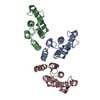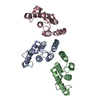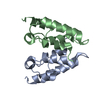+ Open data
Open data
- Basic information
Basic information
| Entry |  | |||||||||||||||
|---|---|---|---|---|---|---|---|---|---|---|---|---|---|---|---|---|
| Title | Cryo-electron tomogram of HTLV-1 MA126CANC tubes | |||||||||||||||
 Map data Map data | cryo-electron tomogram containing HTLV-1 MA126CANC tubes | |||||||||||||||
 Sample Sample |
| |||||||||||||||
 Keywords Keywords | Retrovirus / HTLV / immature capsid / CA / VIRAL PROTEIN | |||||||||||||||
| Biological species |  Human T-cell leukemia virus type I Human T-cell leukemia virus type I | |||||||||||||||
| Method | electron tomography / cryo EM | |||||||||||||||
 Authors Authors | Obr M / Percipalle M / Chernikova D / Yang H / Thader A / Pinke G / Porley D / Mansky LM / Dick RA / Schur FKM | |||||||||||||||
| Funding support |  Austria, Austria,  United States, 4 items United States, 4 items
| |||||||||||||||
 Citation Citation |  Journal: bioRxiv / Year: 2023 Journal: bioRxiv / Year: 2023Title: Unconventional stabilization of the human T-cell leukemia virus type 1 immature Gag lattice. Authors: Martin Obr / Mathias Percipalle / Darya Chernikova / Huixin Yang / Andreas Thader / Gergely Pinke / Dario Porley / Louis M Mansky / Robert A Dick / Florian Km Schur /   Abstract: Human T-cell leukemia virus type 1 (HTLV-1) has an atypical immature particle morphology compared to other retroviruses. This indicates that these particles are formed in a way that is unique. Here ...Human T-cell leukemia virus type 1 (HTLV-1) has an atypical immature particle morphology compared to other retroviruses. This indicates that these particles are formed in a way that is unique. Here we report the results of cryo-electron tomography (cryo-ET) studies of HTLV-1 virus-like particles (VLPs) assembled , as well as derived from cells. This work shows that HTLV-1 employs an unconventional mechanism of Gag-Gag interactions to form the immature viral lattice. Analysis of high-resolution structural information from immature CA tubular arrays reveals that the primary stabilizing component in HTLV-1 is CA-NTD. Mutagenesis and biophysical analysis support this observation. This distinguishes HTLV-1 from other retroviruses, in which the stabilization is provided primarily by the CA-CTD. These results are the first to provide structural details of the quaternary arrangement of Gag for an immature deltaretrovirus, and this helps explain why HTLV-1 particles are morphologically distinct. | |||||||||||||||
| History |
|
- Structure visualization
Structure visualization
| Supplemental images |
|---|
- Downloads & links
Downloads & links
-EMDB archive
| Map data |  emd_17938.map.gz emd_17938.map.gz | 109.5 MB |  EMDB map data format EMDB map data format | |
|---|---|---|---|---|
| Header (meta data) |  emd-17938-v30.xml emd-17938-v30.xml emd-17938.xml emd-17938.xml | 16.4 KB 16.4 KB | Display Display |  EMDB header EMDB header |
| Images |  emd_17938.png emd_17938.png | 231.3 KB | ||
| Archive directory |  http://ftp.pdbj.org/pub/emdb/structures/EMD-17938 http://ftp.pdbj.org/pub/emdb/structures/EMD-17938 ftp://ftp.pdbj.org/pub/emdb/structures/EMD-17938 ftp://ftp.pdbj.org/pub/emdb/structures/EMD-17938 | HTTPS FTP |
-Validation report
| Summary document |  emd_17938_validation.pdf.gz emd_17938_validation.pdf.gz | 581.6 KB | Display |  EMDB validaton report EMDB validaton report |
|---|---|---|---|---|
| Full document |  emd_17938_full_validation.pdf.gz emd_17938_full_validation.pdf.gz | 581.1 KB | Display | |
| Data in XML |  emd_17938_validation.xml.gz emd_17938_validation.xml.gz | 5 KB | Display | |
| Data in CIF |  emd_17938_validation.cif.gz emd_17938_validation.cif.gz | 5.5 KB | Display | |
| Arichive directory |  https://ftp.pdbj.org/pub/emdb/validation_reports/EMD-17938 https://ftp.pdbj.org/pub/emdb/validation_reports/EMD-17938 ftp://ftp.pdbj.org/pub/emdb/validation_reports/EMD-17938 ftp://ftp.pdbj.org/pub/emdb/validation_reports/EMD-17938 | HTTPS FTP |
-Related structure data
| Related structure data |  8pu6C  8pu7C  8pu8C  8pu9C  8puaC  8pubC  8pucC  8pudC  8pueC  8pufC  8pugC  8puhC C: citing same article ( |
|---|
- Links
Links
| EMDB pages |  EMDB (EBI/PDBe) / EMDB (EBI/PDBe) /  EMDataResource EMDataResource |
|---|
- Map
Map
| File |  Download / File: emd_17938.map.gz / Format: CCP4 / Size: 127.4 MB / Type: IMAGE STORED AS FLOATING POINT NUMBER (4 BYTES) Download / File: emd_17938.map.gz / Format: CCP4 / Size: 127.4 MB / Type: IMAGE STORED AS FLOATING POINT NUMBER (4 BYTES) | ||||||||||||||||||||
|---|---|---|---|---|---|---|---|---|---|---|---|---|---|---|---|---|---|---|---|---|---|
| Annotation | cryo-electron tomogram containing HTLV-1 MA126CANC tubes | ||||||||||||||||||||
| Voxel size | X=Y=Z: 10.616 Å | ||||||||||||||||||||
| Density |
| ||||||||||||||||||||
| Symmetry | Space group: 1 | ||||||||||||||||||||
| Details | EMDB XML:
|
-Supplemental data
- Sample components
Sample components
-Entire : Human T-cell leukemia virus type I
| Entire | Name:  Human T-cell leukemia virus type I Human T-cell leukemia virus type I |
|---|---|
| Components |
|
-Supramolecule #1: Human T-cell leukemia virus type I
| Supramolecule | Name: Human T-cell leukemia virus type I / type: virus / ID: 1 / Parent: 0 / Macromolecule list: #1 / NCBI-ID: 11908 / Sci species name: Human T-cell leukemia virus type I / Virus type: VIRUS-LIKE PARTICLE / Virus isolate: STRAIN / Virus enveloped: No / Virus empty: Yes |
|---|
-Experimental details
-Structure determination
| Method | cryo EM |
|---|---|
 Processing Processing | electron tomography |
| Aggregation state | helical array |
- Sample preparation
Sample preparation
| Buffer | pH: 8 Component:
| |||||||||||||||
|---|---|---|---|---|---|---|---|---|---|---|---|---|---|---|---|---|
| Grid | Model: C-flat-2/2 / Material: COPPER / Mesh: 300 / Pretreatment - Type: GLOW DISCHARGE / Pretreatment - Time: 30 sec. / Pretreatment - Atmosphere: AMYLAMINE | |||||||||||||||
| Vitrification | Cryogen name: ETHANE / Chamber humidity: 95 % / Chamber temperature: 283 K / Instrument: LEICA EM GP / Details: Grids coated with 2nm continuous carbon layer. | |||||||||||||||
| Sectioning | Other: NO SECTIONING | |||||||||||||||
| Fiducial marker | Manufacturer: Aurion / Diameter: 10 nm |
- Electron microscopy
Electron microscopy
| Microscope | FEI TITAN KRIOS |
|---|---|
| Specialist optics | Energy filter - Name: GIF Quantum LS / Energy filter - Slit width: 20 eV |
| Image recording | Film or detector model: GATAN K2 QUANTUM (4k x 4k) / Detector mode: COUNTING / Digitization - Dimensions - Width: 3708 pixel / Digitization - Dimensions - Height: 3838 pixel / Average exposure time: 1.05 sec. / Average electron dose: 3.5 e/Å2 |
| Electron beam | Acceleration voltage: 300 kV / Electron source:  FIELD EMISSION GUN FIELD EMISSION GUN |
| Electron optics | Illumination mode: FLOOD BEAM / Imaging mode: BRIGHT FIELD / Cs: 2.7 mm / Nominal defocus max: 3.5 µm / Nominal defocus min: 1.5 µm / Nominal magnification: 105000 |
| Sample stage | Specimen holder model: FEI TITAN KRIOS AUTOGRID HOLDER / Cooling holder cryogen: NITROGEN |
| Experimental equipment |  Model: Titan Krios / Image courtesy: FEI Company |
- Image processing
Image processing
| Final reconstruction | Algorithm: BACK PROJECTION / Software - Name:  IMOD (ver. 4.9.10) / Details: Weighted back projection with SIRT-like filter / Number images used: 41 IMOD (ver. 4.9.10) / Details: Weighted back projection with SIRT-like filter / Number images used: 41 |
|---|
-Atomic model buiding 1
| Initial model | PDB ID: Chain - Residue range: 13-125 / Chain - Source name: PDB / Chain - Initial model type: experimental model / Details: CA numbering of residues |
|---|---|
| Refinement | Space: REAL / Protocol: AB INITIO MODEL |
 Movie
Movie Controller
Controller



















